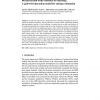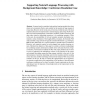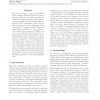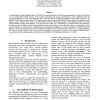184 search results - page 29 / 37 » Learning Expressive Models for Word Sense Disambiguation |
IPMU
2010
Springer
14 years 13 days ago
2010
Springer
We introduce a general definition for the independence of a number of finite-valued variables, based on coherent lower previsions. Our definition has an epistemic flavour: it a...
NC
2002
13 years 7 months ago
2002
Second order statistics have formed the basis of learning and adaptation due to its appeal and analytical simplicity. On the other hand, in many realistic engineering problems requ...
SEMWEB
2010
Springer
13 years 5 months ago
2010
Springer
Systems based on statistical and machine learning methods have been shown to be extremely effective and scalable for the analysis of large amount of textual data. However, in the r...
KDD
2004
ACM
14 years 8 months ago
2004
ACM
We use clustering to derive new relations which augment database schema used in automatic generation of predictive features in statistical relational learning. Clustering improves...
LREC
2008
13 years 9 months ago
2008
Notwithstanding its acknowledged richness, the SIMPLE semantic model does not offer the representational vocabulary for encoding some conceptual links holding between events and t...




